Tungsten-Based Hybrid Composite Shield for Medical Radioisotope Defense
Abstract
:1. Introduction
2. Materials and Methods
3. Results
4. Discussion
5. Conclusions
Funding
Institutional Review Board Statement
Informed Consent Statement
Data Availability Statement
Conflicts of Interest
References
- Afkham, Y.; Mesbahi, A.; Alemi, A.; Zolfagharpour, F.; Jabbari, N. Design and fabrication of a Nano-based neutron shield for fast neutrons from medical linear accelerators in radiation therapy. Radiat. Oncol. 2020, 15, 1–13. [Google Scholar] [CrossRef] [PubMed]
- Love, C.; Palestro, C. Nuclear medicine imaging of bone infections. Clin. Radiol. 2016, 71, 632–646. [Google Scholar] [CrossRef] [PubMed]
- Ge, J.; Zhang, Q.; Zeng, J.; Gu, Z.; Gao, M. Radiolabeling nanomaterials for multimodality imaging: New insights into nuclear medicine and cancer diagnosis. Biomater 2020, 228, 119553. [Google Scholar] [CrossRef] [PubMed]
- Pellico, J.; Gawne, P.J.; de Rosales, R.T.M. Radiolabelling of nanomaterials for medical imaging and therapy. Chem. Soc. Rev. 2021, 50, 3355–3423. [Google Scholar] [CrossRef] [PubMed]
- Kamiya, K.; Ozasa, K.; Akiba, S.; Niwa, O.; Kodama, K.; Takamura, N.; Zaharieva, E.K.; Kimura, Y.; Wakeford, R. Long-term effects of radiation exposure on health. Lancet 2015, 386, 469–478. [Google Scholar] [CrossRef]
- Tharmalingam, S.; Sreetharan, S.; Kulesza, A.V.; Boreham, D.R.; Tai, T.C. Low-Dose Ionizing Radiation Exposure, Oxidative Stress and Epigenetic Programing of Health and Disease. Radiat. Res. 2017, 188, 525–538. [Google Scholar] [CrossRef]
- Lumniczky, K.; Impens, N.; Armengol, G.; Candéias, S.; Georgakilas, A.G.; Hornhardt, S.; Martin, O.A.; Rödel, F.; Schaue, D. Low dose ionizing radiation effects on the immune system. Environ. Int. 2021, 149, 106212. [Google Scholar] [CrossRef]
- Yin, W.-W.; Zheng, X.-W.; Wang, Z.-Q.; Chen, W.-J.; Tyan, Y.-S.; Chen, T.-R. Ambient and personnel occupational dose assessment in a Hospital’s PET/CT center. Appl. Radiat. Isot. 2021, 169, 109466. [Google Scholar] [CrossRef]
- Majunatha, H.C.; Sathish, K.B.; Seenappa, L.; Gupta, D.; Celcil Raj, S.A. A study of X-ray, gamma and neutron shielding parameters in Si- alloys. Radiat. Phys. Chem. 2019, 165, 1–9. [Google Scholar] [CrossRef]
- Sayyed, M.I.; Akamn, F.; Kaçal, M.R.; Kumar, A. Radiation protective qualities of some selected lead and bismuth salts in the wide gamma energy region. Nucl. Eng. Technol. 2019, 51, 860–866. [Google Scholar] [CrossRef]
- Çetin, H.; Yurt, A.; Yüksel, S.H. The absorption properties of lead-free garments for use in radiation protection. Radiat. Prot. Dosim. 2016, 173, 345–350. [Google Scholar] [CrossRef] [PubMed]
- Seenappa, L.; Manjunatha, H.; Chandrika, B.; Chikka, H. A study of shielding properties of x-ray and gamma in barium compounds. J. Radiat. Prot. Res. 2017, 42, 26–32. [Google Scholar] [CrossRef] [Green Version]
- Adlienė, D.; Gilys, L.; Griškonis, E. Development and characterization of new tungsten and tantalum containing composites for radiation shielding in medicine. Nucl. Instrum. Methods Phys. Res. Sect. B Beam Interact. Mater. Atoms 2020, 467, 21–26. [Google Scholar] [CrossRef]
- Akman, F.; Agar, O.; Kaçal, M.R.; Sayyed, M.I. Comparison of experimental and theoretical radiation shielding parameters of several environmentally friendly materials. Nucl. Sci. Technol. 2019, 30, 110. [Google Scholar] [CrossRef]
- Abu AlRoos, N.J.; Azman, M.N.; Amin, N.A.B.; Zainon, R. Tungsten-based material as promising new lead-free gamma radiation shielding material in nuclear medicine. Phys. Med. 2020, 78, 48–57. [Google Scholar] [CrossRef]
- Singh, A.K.; Singh, R.K.; Sharma, B.; Tyagi, A.K. Characterization and biocompatibility studies of lead free X-ray shielding polymer composite for healthcare application. Radiat. Phys. Chem. 2017, 138, 9–15. [Google Scholar] [CrossRef]
- Maghrabi, H.A.; Vijayan, A.; Deb, P.; Wang, L. Bismuth oxide-coated fabrics for X-ray shielding. Text. Res. J. 2015, 86, 649–658. [Google Scholar] [CrossRef]
- Aral, N.; Duch, M.A.; Nergis, F.B.; Candan, C. The effect of tungsten particle sizes on X-ray attenuation properties. Radiat. Phys. Chem. 2021, 187, 109586. [Google Scholar] [CrossRef]
- More, C.V.; Alsayed, Z.; Badawi, M.S.; Thabet, A.A.; Pawar, P.P. Polymeric composite materials for radiation shielding: A review. Environ. Chem. Lett. 2021, 19, 2057–2090. [Google Scholar] [CrossRef]
- Özdemir, T.; Güngör, A.; AkbayI, K.; Uzun, H.; Babucçuoglu, Y. Nano lead oxide and epdm composite for development of polymer based radiation shielding material: Gamma irradiation and attenuation tests. Radiat. Phys. Chem. 2018, 144, 248–255. [Google Scholar] [CrossRef]
- Agar, O.; Khattari, Z.; Sayyed, M.; Tekin, H.O.; Al-Omari, S.; Maghrabi, M.; Zaid, M.; Kityk, I. Evaluation of the shielding parameters of alkaline earth based phosphate glasses using MCNPX code. Results Phys. 2019, 12, 101–106. [Google Scholar] [CrossRef]
- Kaloshkin, S.; Tcherdyntsev, V.; Gorshenkov, M.; Gulbin, V.; Kuznetsov, S. Radiation-protective polymer-matrix nanostructured composites. J. Alloys Compd. 2012, 536, S522–S526. [Google Scholar] [CrossRef]
- More, C.V.; Alavian, H.; Pawar, P.P. Evaluation of gamma-ray attenuation characteristics of some thermoplastic polymers: Experimental, WinXCom and MCNPX studies. J. Non-Cryst. Solids 2020, 546, 120277. [Google Scholar] [CrossRef]
- Saudi, H.A.; El Kameesy, S.U. Effect of barium addition and plasma nitriding treatment on chemical and physical properties of Al, Pb borate glass system as a developed radiation shield. J. Phys. Conf. Ser. 2019, 1253, 012033. [Google Scholar] [CrossRef]
- Hojiyev, R.; Ulcay, Y.; Çelik, M.S. Poly(ethylene terephthalate)–Clay Nanocomposite multifilament yarn: Physical and thermal properties. Polym. Sci. Ser. A 2020, 62, 392–406. [Google Scholar] [CrossRef]
- Kim, S.-C. Construction of a Medical radiation-shielding environment by analyzing the weaving characteristics and shielding performance of shielding fibers using x-ray-impermeable materials. Appl. Sci. 2021, 11, 1705. [Google Scholar] [CrossRef]
- Park, T.-L.; Yang, Y.-M.; Shin, D.-G.; Kim, D.-E. A study on frictional characteristics of PDMS under various conditions. J. Korean Soc. Precis. Eng. 2018, 35, 803–807. [Google Scholar] [CrossRef]
- Chon, K.S. Monte carlo simulation for radiation protection sheets of Pb-free. J. Korean Soc. Radiol. 2017, 11, 189–195. [Google Scholar] [CrossRef] [Green Version]
- Korean Standards Association. Testing method of lead equivalent for X-ray protective devices. KSA 2017, 17, 4025. [Google Scholar]
- Kim, S.-C. Research on performance improvement measures for medical radiation shielding film through removal of air bubbles and pinholes. Radiat. Eff. Defects Solids 2021, 176, 718–730. [Google Scholar] [CrossRef]
- Han, S.H. Evaluation of shielding rate of bismuth depending on the type of medical radioisotope. J. Korea Con-Vergence Soc. 2018, 9, 87–93. [Google Scholar] [CrossRef]
- Lee, W.-H.; Ahn, S.-M. Evaluation of reductive effect of exposure dose by using air gap apron in nuclear medicine related work environment. J. Korea Contents Assoc. 2014, 14, 845–853. [Google Scholar] [CrossRef] [Green Version]
- Chang, B.S. A study on the validation of effective angle of particle deposition according to the detection efficiency of high-purity germanium gamma-ray detector. J. Korean Soc. Radiol. 2020, 14, 487–494. [Google Scholar] [CrossRef]
- Guo-Hui, W.; Man-Li, H.; Fan-Chao, C.; Jun-Dong, F.; Yao-Dong, D. Enhancement of flame retardancy and radiation shielding properties of ethylene vinyl acetate based radiation shielding composites by EB irradiation. Prog. Nucl. Energy 2019, 112, 225–232. [Google Scholar] [CrossRef]
- El-Qoubaa, Z.; Othman, R. Temperature, strain rate and pressure sensitivity of the polyetheretherketone’s yield stress. Int. J. Appl. Mech. 2017, 9, 1750099. [Google Scholar] [CrossRef]
- Jadiyappa, S. Radioisotope: Applications, Effects, and Occupational Protection; IntechOpen: London, UK, 2018; pp. 1–30. [Google Scholar] [CrossRef] [Green Version]
- Tan, H.Y.; Yeong, C.H.; Wong, Y.H.; McKenzie, M.; Kasbollah, A.; Shah, M.N.M.; Perkins, A.C. Neutron-activated theranostic radionuclides for nuclear medicine. Nucl. Med. Biol. 2020, 90–91, 55–68. [Google Scholar] [CrossRef]
- Adliene, D.; Griciene, B.; Skovorodko, K.; Laurikaitiene, J.; Puiso, J. Occupational radiation exposure of health professionals and cancer risk assessment for Lithuanian nuclear medicine workers. Environ. Res. 2020, 183, 109144. [Google Scholar] [CrossRef]
- Abu AlRoos, N.J.; Amin, N.A.B.; Zainon, R. Conventional and new lead-free radiation shielding materials for radiation protection in nuclear medicine: A review. Radiat. Phys. Chem. 2019, 165, 108439. [Google Scholar] [CrossRef]
- Marcusohn, E.; Postnikov, M.; Musallam, A.; Yalonetsky, S.; Mishra, S.; Kerner, A.; Poliakov, A.; Roguin, A. Usefulness of pelvic radiation protection shields during transfemoral procedures—Operator and patient considerations. Am. J. Cardiol. 2018, 122, 1098–1103. [Google Scholar] [CrossRef]
- Alkhorayef, M.; Mayhoub, F.H.; Salah, H.; Sulieman, A.; Al-Mohammed, H.; Almuwannis, M.; Kappas, C.; Bradley, D. Assessment of occupational exposure and radiation risks in nuclear medicine departments. Radiat. Phys. Chem. 2020, 170, 108529. [Google Scholar] [CrossRef]
- Jang, D.-G.; Park, E.-T. Analysis of scattering rays and shielding efficiency through lead shielding for 0.511 MeV gamma rays based on skin dose. J. Radiol. Sci. Technol. 2020, 43, 259–264. [Google Scholar] [CrossRef]
- Kim, S.-C.; Son, J.-S. Manufacturing and performance evaluation of medical radiation shielding fiber with plasma thermal spray coating technology. Sci. Rep. 2021, 11, 22418. [Google Scholar] [CrossRef] [PubMed]
- Livingstone, R.S.; Varghese, A.; Keshava, S.N. A study on the use of radiation-protective apron among interventionists in radiology. J. Clin. Imaging Sci. 2018, 8, 34. [Google Scholar] [CrossRef] [PubMed]

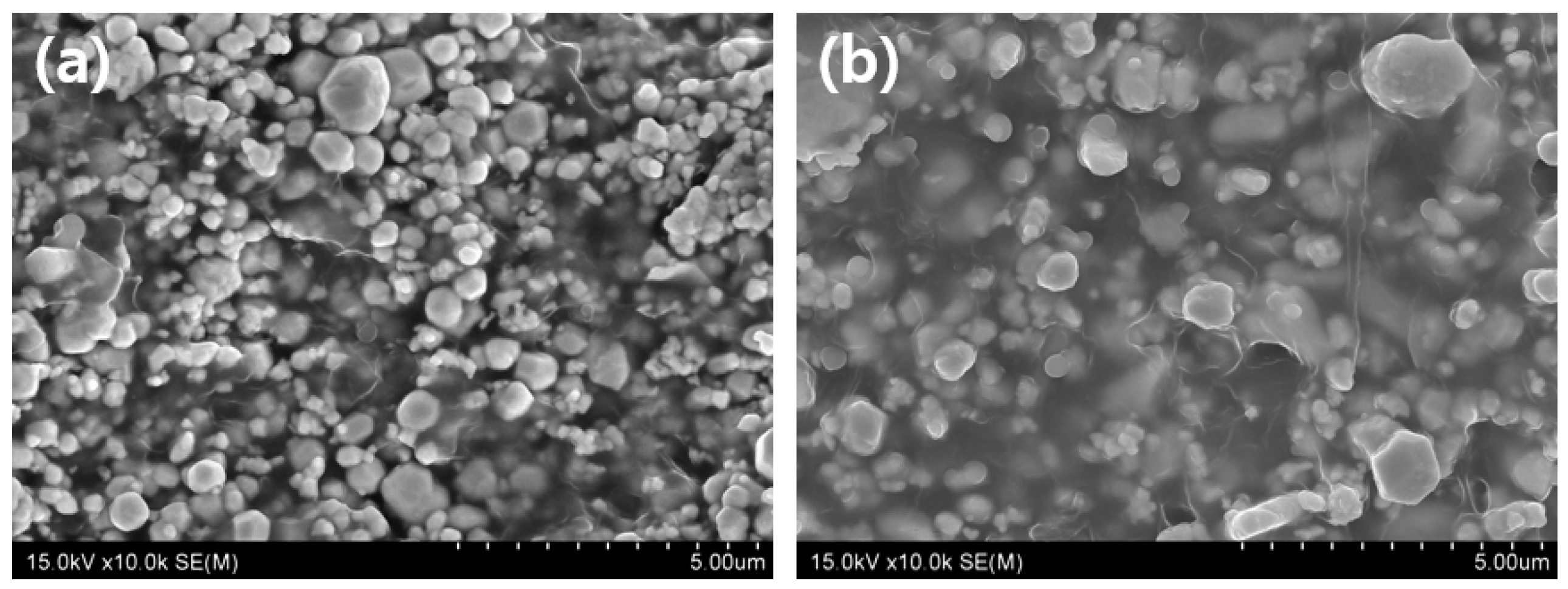
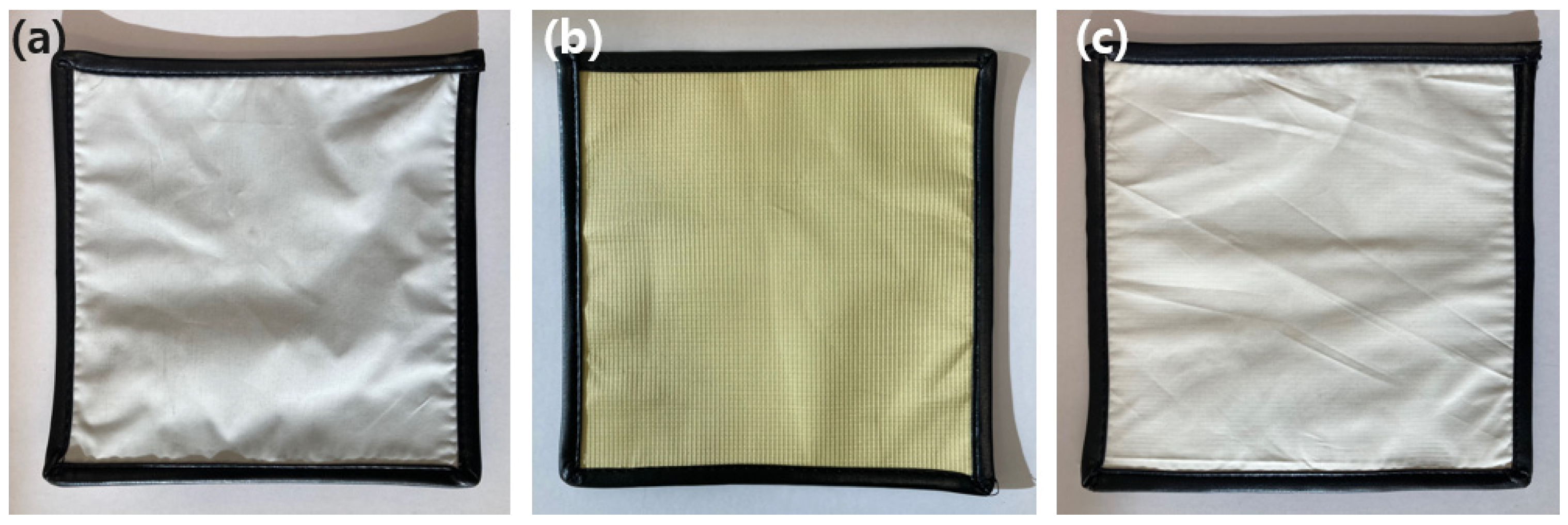
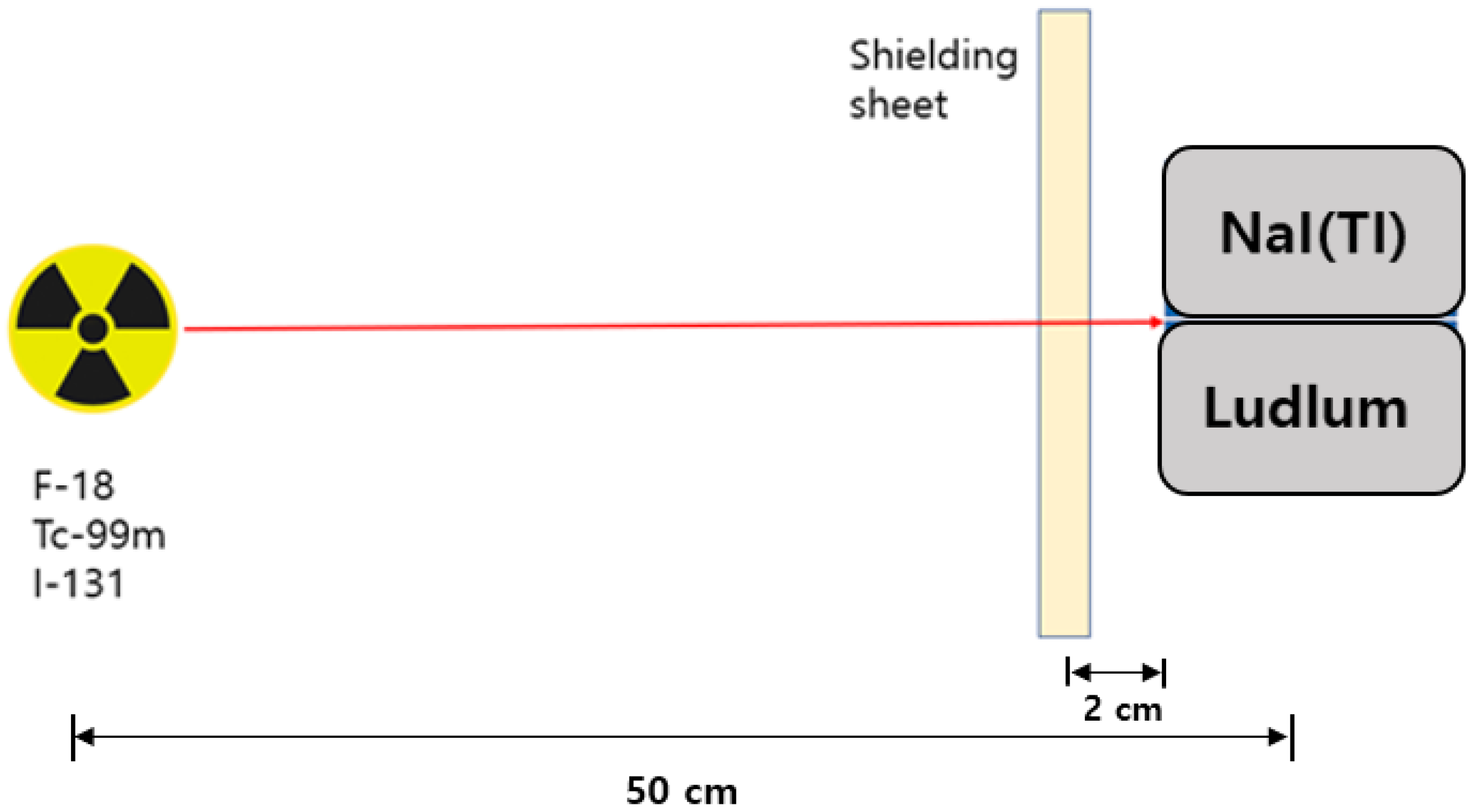
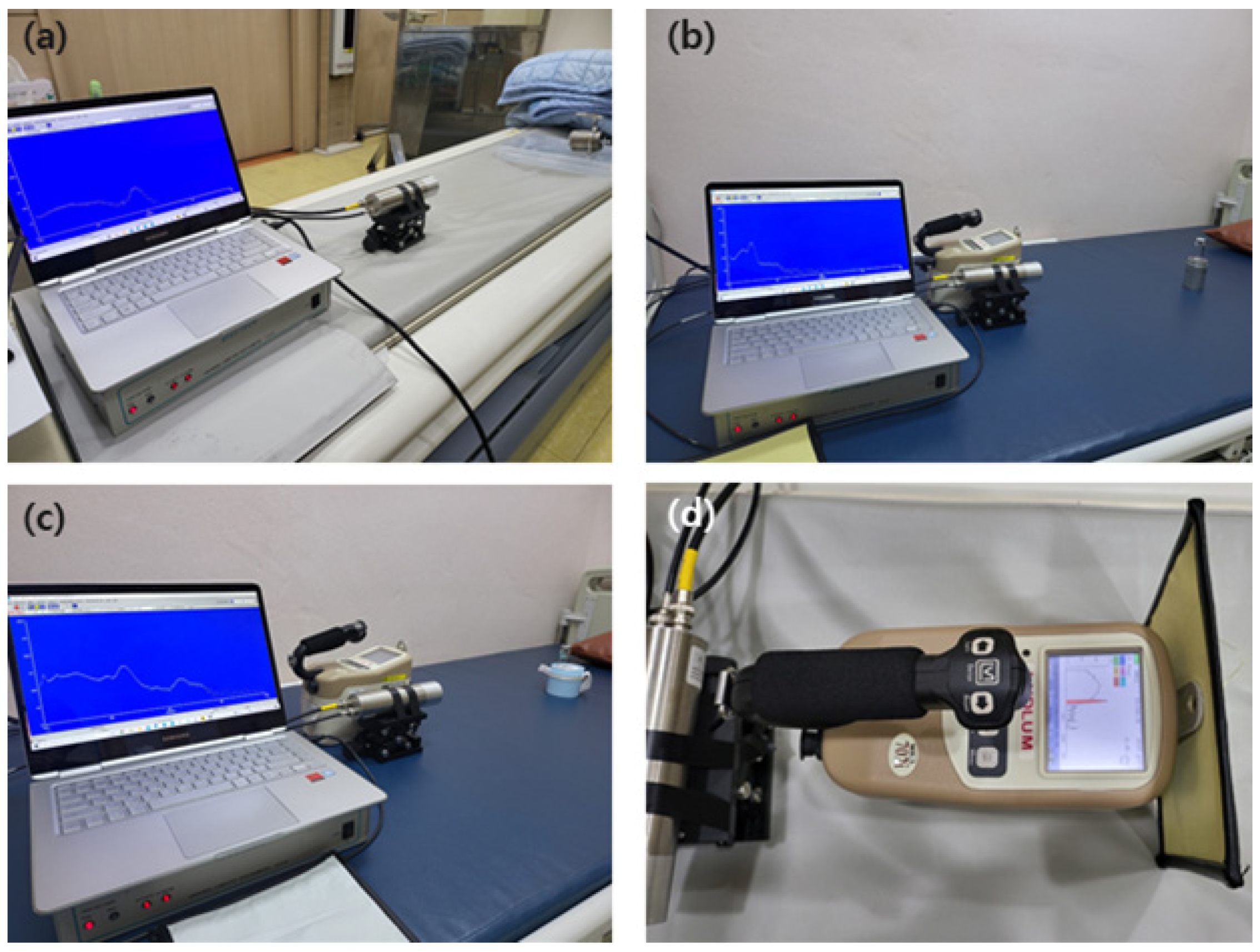
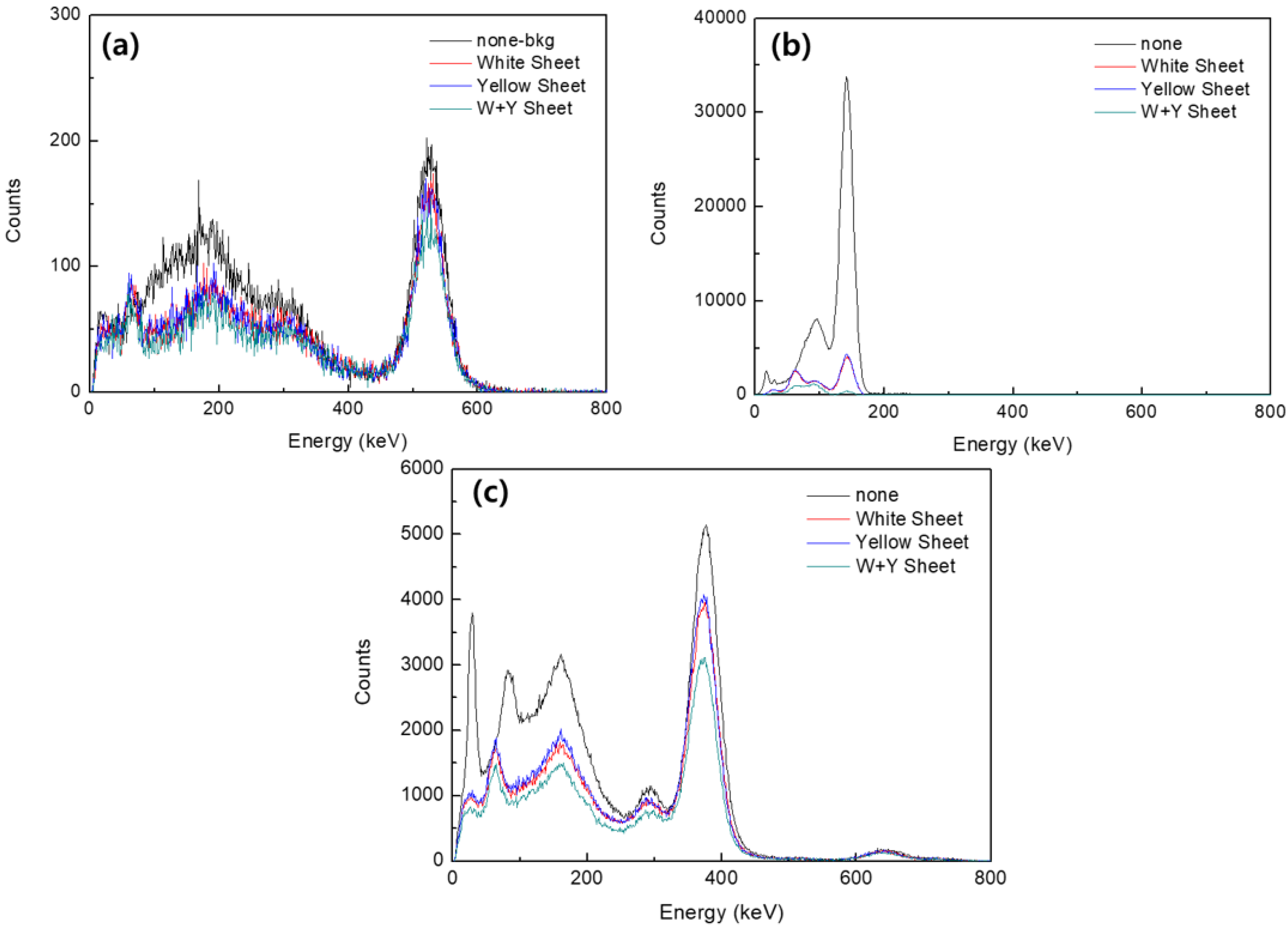

| Composite Yarn | Shielding Fiber | |||||
|---|---|---|---|---|---|---|
| Fineness (D) | Tensile Strength (g/d) | Elongation at Break (%) | Tread Count (Thread/Inch) | Weight (g/m2) | Thickness (mm) | |
| Warp | Weft | |||||
| 501.1 | 1.45 | 4.2 | 80 | 60 | 112–121 | 0.20–0.21 |
| Shields | Shielding Rate of Radio-Isotope (%) | Detector | ||
|---|---|---|---|---|
| F-18 | Tc-99m | I-131 | ||
| Tungsten Shielding Sheet (0.55 mmPb) | 11.9 | 66.4 | 19.3 | Harvest |
| 12.4 | 69.5 | 22.1 | Ludlum | |
| Barium Sulfate Fabric Bonding Shield (White) | 13.0 | 76.5 | 20.8 | Harvest |
| 14.8 | 79.0 | 24.0 | Ludlum | |
| Bismuth Oxide Fabric Bonding Shield (Yellow) | 15.4 | 75.1 | 18.8 | Harvest |
| 12.6 | 80.7 | 21.6 | Ludlum | |
| Composite Fabric Bonding (White + Yellow) | 25.3 | 90.5 | 36.1 | Harvest |
| 27.0 | 89.5 | 37.3 | Ludlum | |
Publisher’s Note: MDPI stays neutral with regard to jurisdictional claims in published maps and institutional affiliations. |
© 2022 by the author. Licensee MDPI, Basel, Switzerland. This article is an open access article distributed under the terms and conditions of the Creative Commons Attribution (CC BY) license (https://creativecommons.org/licenses/by/4.0/).
Share and Cite
Kim, S.-C. Tungsten-Based Hybrid Composite Shield for Medical Radioisotope Defense. Materials 2022, 15, 1338. https://doi.org/10.3390/ma15041338
Kim S-C. Tungsten-Based Hybrid Composite Shield for Medical Radioisotope Defense. Materials. 2022; 15(4):1338. https://doi.org/10.3390/ma15041338
Chicago/Turabian StyleKim, Seon-Chil. 2022. "Tungsten-Based Hybrid Composite Shield for Medical Radioisotope Defense" Materials 15, no. 4: 1338. https://doi.org/10.3390/ma15041338
APA StyleKim, S.-C. (2022). Tungsten-Based Hybrid Composite Shield for Medical Radioisotope Defense. Materials, 15(4), 1338. https://doi.org/10.3390/ma15041338






